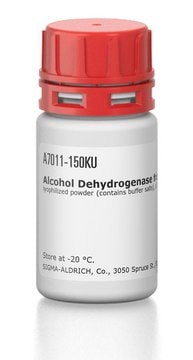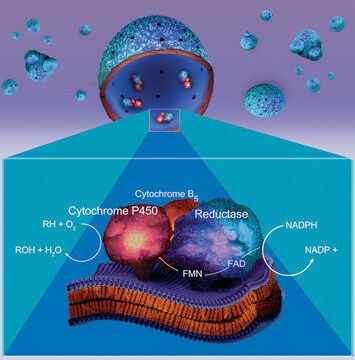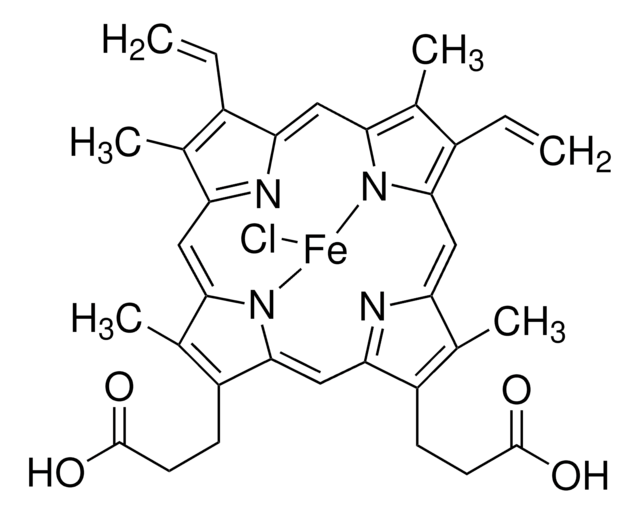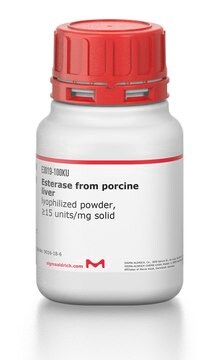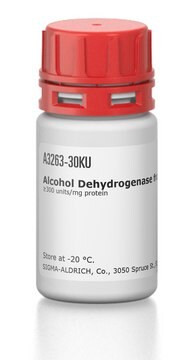F8649
Formate Dehydrogenase from Candida boidinii
lyophilized powder, 5.0-15.0 units/mg protein
Synonyme(s) :
FDH, Formate:NAD+ oxidoreductase
Se connecterpour consulter vos tarifs contractuels et ceux de votre entreprise/organisme
About This Item
Produits recommandés
Source biologique
fungus (Candida boidinii)
Niveau de qualité
Forme
lyophilized powder
Activité spécifique
5.0-15.0 units/mg protein
Composition
Protein, 5.0-20.0% biuret
Température de stockage
2-8°C
Vous recherchez des produits similaires ? Visite Guide de comparaison des produits
Application
Formate Dehydrogenase (FDH) is used for diagnostics in large scale industrial processes. Its used in the production of an unnatural amino acid, tert-L-leucine, a component of some HIV protease and matrix metalloprotease inhibitors.
Actions biochimiques/physiologiques
Formate dehydrogenase is an abundant enzyme from yeast Candida boidinii (CbFDH) that plays an important role in the energy supply of methylotrophic microorganisms and in the stress response of plants.
Formate dehydrogenase is involved in the stress response of plants and catalyzes the reduction of NAD+ to NADH.
Définition de l'unité
One unit will oxidize 1.0 μmole of formate to CO2 per min in the presence of β-NAD at pH 7.6 at 37 °C.
Mention d'avertissement
Danger
Mentions de danger
Conseils de prudence
Classification des risques
Resp. Sens. 1
Code de la classe de stockage
11 - Combustible Solids
Classe de danger pour l'eau (WGK)
WGK 3
Point d'éclair (°F)
Not applicable
Point d'éclair (°C)
Not applicable
Équipement de protection individuelle
Eyeshields, Gloves, type N95 (US)
Faites votre choix parmi les versions les plus récentes :
Déjà en possession de ce produit ?
Retrouvez la documentation relative aux produits que vous avez récemment achetés dans la Bibliothèque de documents.
Les clients ont également consulté
Held in police custody.
A Skelt
Nursing times, 84(4), 50-52 (1988-01-02)
Jana Löwe et al.
Scientific reports, 8(1), 10436-10436 (2018-07-12)
A biotechnological process is reported, which enables an enzymatic reduction without the need for addition of an organic co-substrate for in situ-cofactor recycling. The process is based on merging the fields of enzymatic reductive amination with formate dehydrogenase-based in situ-cofactor
Frances L Shaw et al.
Journal of bacteriology, 194(15), 3814-3823 (2012-05-23)
The food-borne bacterial pathogen Campylobacter jejuni efficiently utilizes organic acids such as lactate and formate for energy production. Formate is rapidly metabolized via the activity of the multisubunit formate dehydrogenase (FDH) enzyme, of which the FdhA subunit is predicted to
Yutaka Amao et al.
Faraday discussions, 155, 289-296 (2012-04-05)
Solar fuels, such as hydrogen gas produced from water and methanol produced from carbon dioxide reduction by artificial photosynthesis, have received considerable attention. In natural leaves the photosynthetic proteins are well-organized in the thylakoid membrane. To develop an artificial leaf
Mark Pryjma et al.
Journal of bacteriology, 194(15), 3803-3813 (2012-05-29)
Campylobacter jejuni is a food-borne bacterial pathogen that colonizes the intestinal tract and causes severe gastroenteritis. Interaction with host epithelial cells is thought to enhance severity of disease, and the ability of C. jejuni to modulate its metabolism in different
Notre équipe de scientifiques dispose d'une expérience dans tous les secteurs de la recherche, notamment en sciences de la vie, science des matériaux, synthèse chimique, chromatographie, analyse et dans de nombreux autres domaines..
Contacter notre Service technique
